中考英语专题复习(六)代词课件(共69张)
文档属性
| 名称 | 中考英语专题复习(六)代词课件(共69张) |  | |
| 格式 | zip | ||
| 文件大小 | 4.9MB | ||
| 资源类型 | 教案 | ||
| 版本资源 | 通用版 | ||
| 科目 | 英语 | ||
| 更新时间 | 2018-11-05 09:11:29 | ||
图片预览

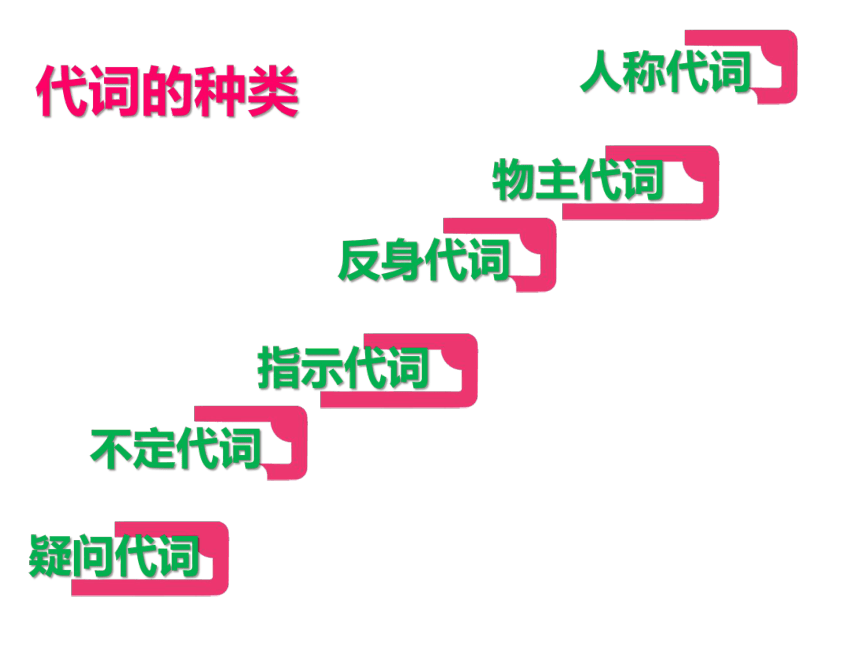
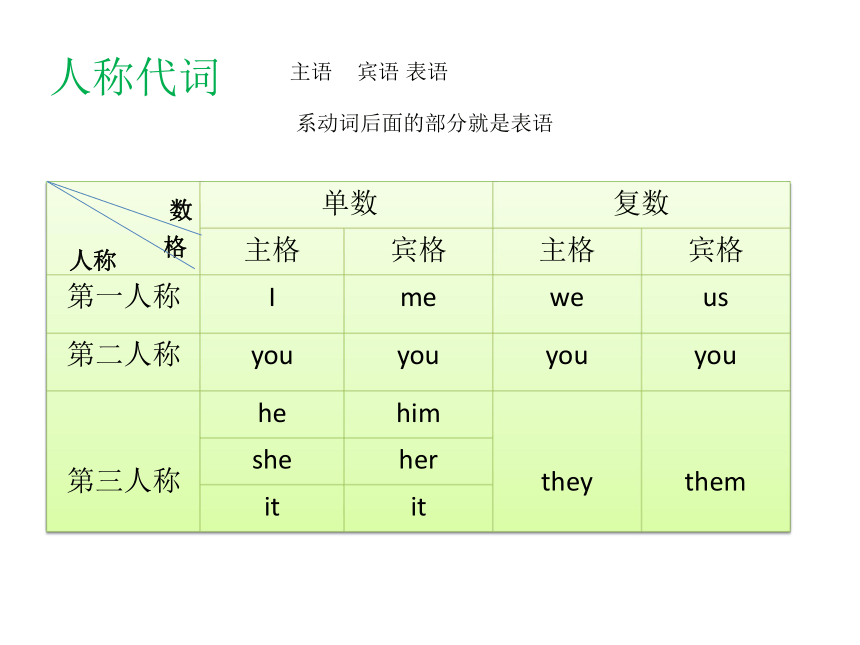

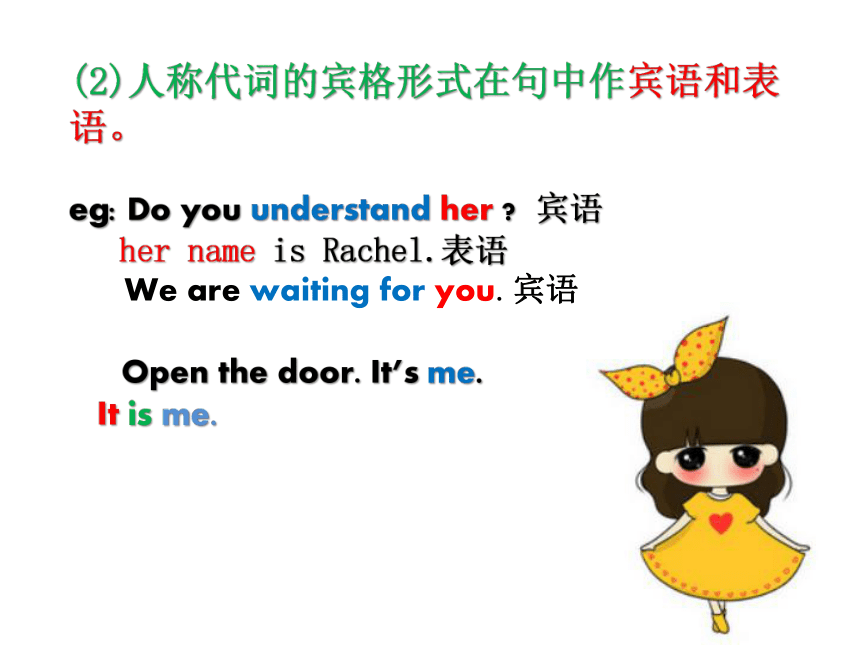

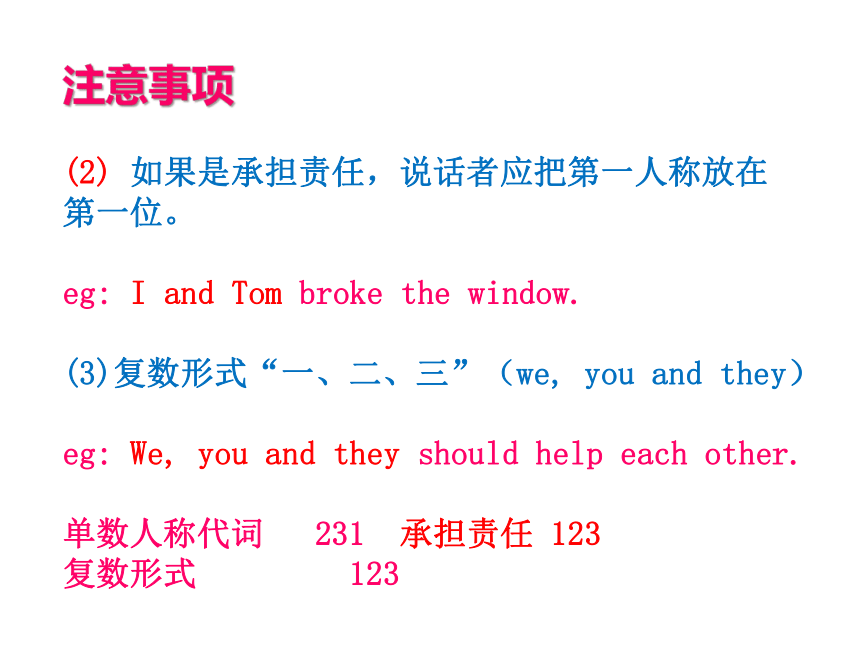
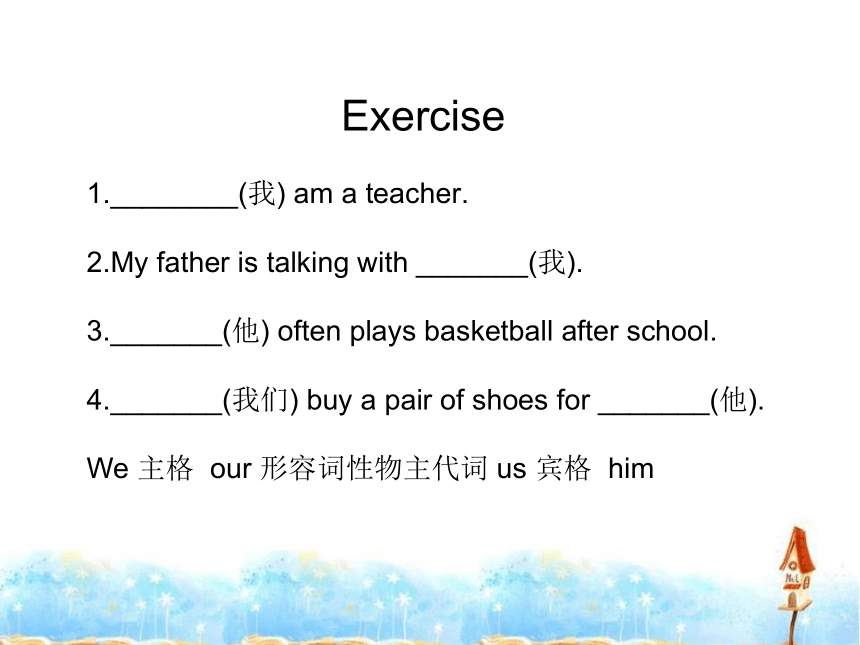
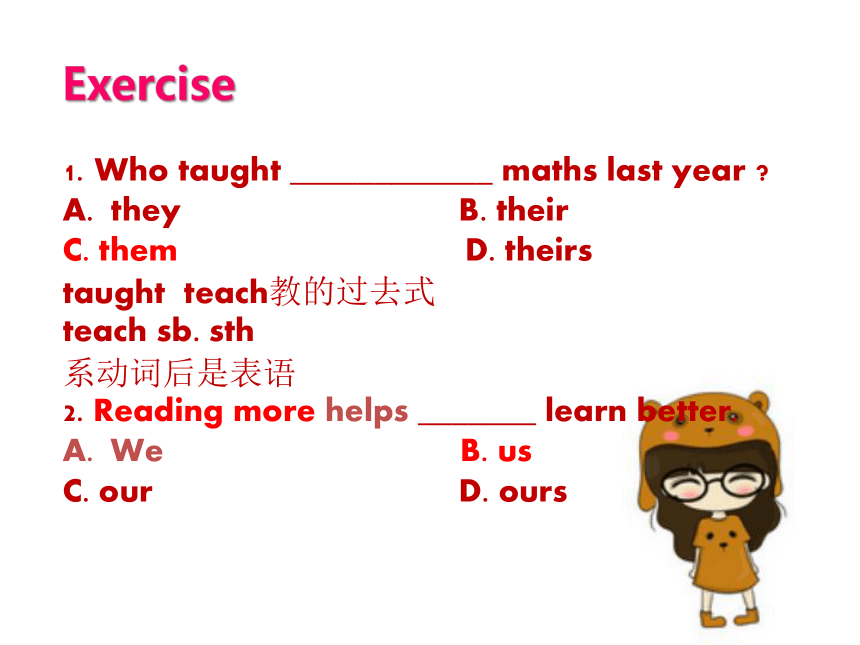
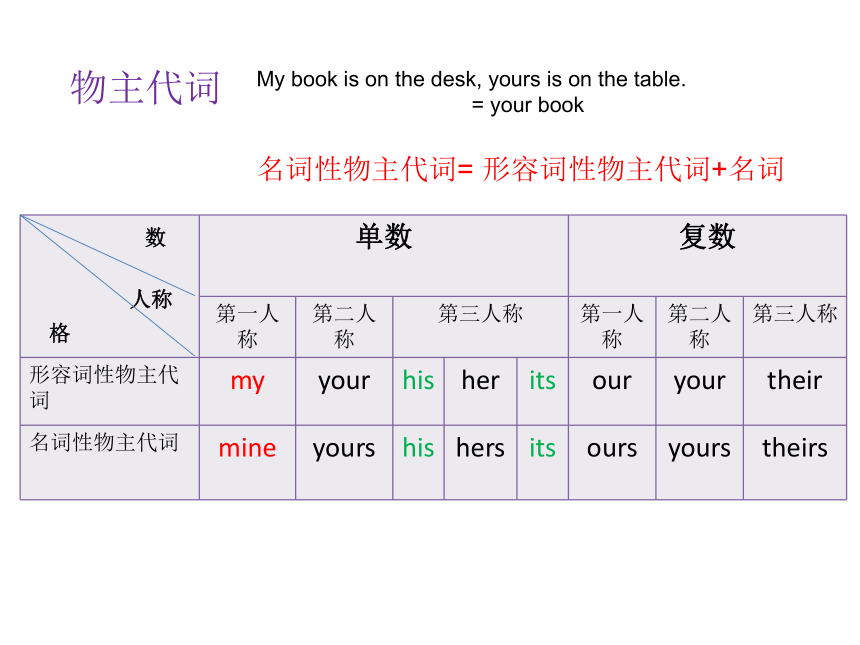
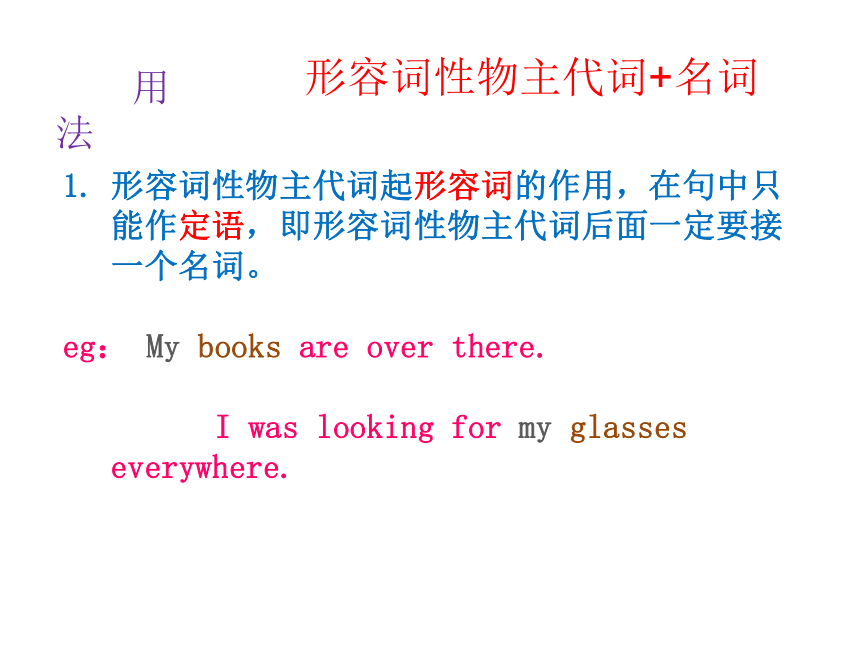
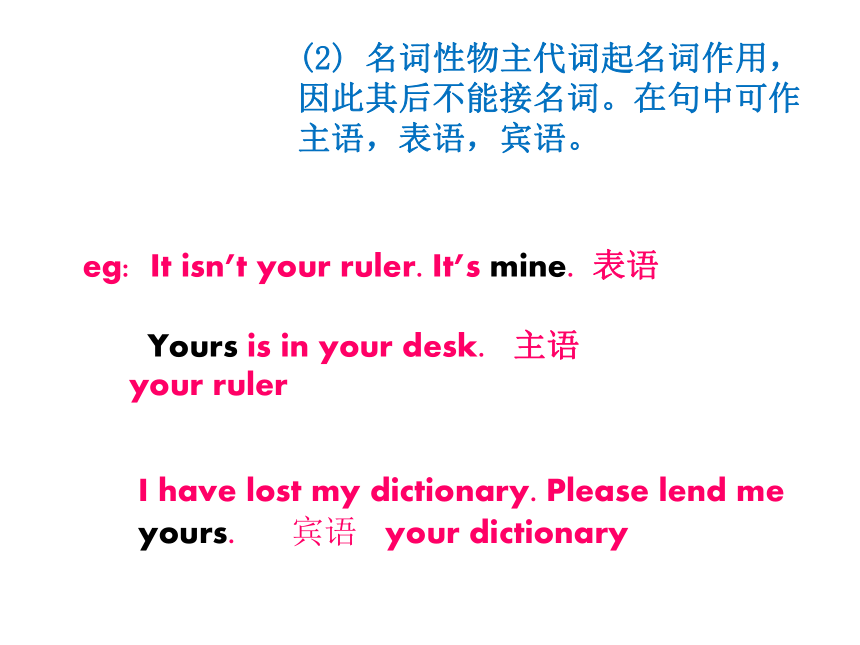
文档简介
课件69张PPT。英语语法课程
之代词点击添加文本点击添加文本点击添加文本点击添加文本代词的种类人称代词物主代词反身代词指示代词不定代词疑问代词点击添加文本点击添加文本点击添加文本点击添加文本人称代词数格人称主语 宾语 表语
系动词后面的部分就是表语点击添加文本点击添加文本点击添加文本点击添加文本1.句法功用(1)人称代词的主格形式在句中作主语等成分。
eg: They are all good students.
She is going to another city.
her点击添加文本点击添加文本点击添加文本点击添加文本(2)人称代词的宾格形式在句中作宾语和表语。
eg: Do you understand her ? 宾语
her name is Rachel.表语
We are waiting for you. 宾语
Open the door. It’s me.
It is me.
点击添加文本点击添加文本点击添加文本点击添加文本2. 注意事项如果同时出现多个人称代词,注意排序。
(1) 为了表示礼貌和谦虚,排列次序总是习惯将第二人称、第三人称放在前面,将第一人称放在后面。单数 “二三一 you he /she/it I”
Eg: He and I like green tea.
You, she and I should help each other.
点击添加文本点击添加文本点击添加文本点击添加文本注意事项(2) 如果是承担责任,说话者应把第一人称放在第一位。
eg: I and Tom broke the window.
(3)复数形式“一、二、三”(we, you and they)
eg: We, you and they should help each other.
单数人称代词 231 承担责任 123
复数形式 123
Exercise
1.________(我) am a teacher.
2.My father is talking with _______(我).
3._______(他) often plays basketball after school.
4._______(我们) buy a pair of shoes for _______(他).
We 主格 our 形容词性物主代词 us 宾格 him点击添加文本点击添加文本点击添加文本点击添加文本ExerciseWho taught ____________ maths last year ?
they B. their
C. them D. theirs
taught teach教的过去式
teach sb. sth
系动词后是表语
2. Reading more helps _______ learn better.
We B. us
C. our D. ours
点击添加文本点击添加文本点击添加文本点击添加文本物主代词数人称格My book is on the desk, yours is on the table.
= your book
名词性物主代词= 形容词性物主代词+名词 点击添加文本点击添加文本点击添加文本点击添加文本 用 法形容词性物主代词起形容词的作用,在句中只能作定语,即形容词性物主代词后面一定要接一个名词。
eg: My books are over there.
I was looking for my glasses everywhere.
形容词性物主代词+名词点击添加文本点击添加文本点击添加文本点击添加文本(2) 名词性物主代词起名词作用,因此其后不能接名词。在句中可作主语,表语,宾语。
eg: It isn’t your ruler. It’s mine. 表语
Yours is in your desk. 主语
your ruler
I have lost my dictionary. Please lend me
yours. 宾语 your dictionary
Exercise
1.My book is blue. __Yours_______(you) is red.
2.Our chair is better than __ chair( they).
3.I will give the presents to________(they).
4.These books are________(I), and those are____(you).
点击添加文本点击添加文本点击添加文本点击添加文本反身代词人称数点击添加文本点击添加文本点击添加文本点击添加文本习惯用语by oneself 独自的 enjoy oneself 玩的开心 teach oneself 自学 make oneself at home 无拘束 look after oneself 自己照顾自己say to oneself 自言自语; 暗自思量 点击添加文本点击添加文本点击添加文本点击添加文本Exercise5. We can’t leave our grandparents by _____.
they B. them
C. themself D. themselves
6. Be careful with that knife, or you’ll cut
_______.
A. himself B. ourselves
C. yourself D. themselves人称代词,物主代词,反身代词总表 指示代词“这个”“那个”
“这些”“那些”用法
this, that用于指代单数名词;these, those用于指代复数可数。
eg: This is my book, and these are yours.
Those cars are made in China.
2. this/ these一般指时间或空间上较近的人或物而
that/those常指时间上或空间上离说话人较远的
人或物。
eg: This present is for you and that one is for
your mom.
We are very happy these days.
3. 为了避免重复,可用that/those用来指代前面提
到的名词。
eg: This book is not so interesting as that I read
yesterday.
The vegetables in this store are cheaper than those
in that store.
4. this,that在电话用语中可以指自己和对方。
eg: A: Is that Mr. Smith speaking ?
B: Who is that ?
A: This is Mary, Mr. Smith.
疑问代词用来表达疑问或构成疑问句的代词。指代格Who是主格,用于询问别人的姓名、身份或关系,在句中作主语或表语;whom是宾格,在句中作宾语。
Eg: who put the light out ?
Who is that girl?
Whom/who did you meet last night?
Whom is Tom talking about ?1. Who 和whom的用法Whose既可以作名词用,也可以作形容词用。
Eg :whose book is this ?
whose is the desk ?2. Whose 的用法What 既可以作名词用,也可以作形容词用。
Eg :What makes him so happy?
what class does he teach ?
what is she ?
what are you doing ?
3. What 的用法Which表示在一定范围内选择,意为
“哪一个”,回答通常为一个。
Eg :This is mine. Which is yours ?
which of you is the oldest?
which would you like, tea or coffee?
which book is more interesting ?
4. Which 的用法不定代词 不明确指代某个人或某些人、某个事物或某些事物
的代词。 不确定的
人或物 不确定的
数量 不确定的
选择1表示不确定的人或事物的不定代词one 某人或事物 some 某个某些 any 任何一个
no 没有 each/every 每个 none 没有
other 别的 another另一个 something 某事
somebody/someone 某人
anybody /anyone 任何一个人
everybody/everyone 每个人
nobody/no one 没有人2表示不确定的数量的不定代词 many 许多 much 许多
few 很少 little 很少
most 大部分 all 全部3表示不确定的选择的不定代词either 两者中的任意一个
neither 两者中没有一个
none 三者或三者以上 不定代词不明确指代某个人、某些人或某些事物的代词。常见不定代词的用法和辨析:
Some, any
many, much
both, all, either, neither
none, no one
few, a few, little, a little
each, every
it, one, that
other, another
Some 和 any
Some 和any 均表示“一些”。
e.g. :There are some trees behind the house.
Do you have any questions ?
Would you like some tea?
You may go there any time.
注意(1)some和any都可以表示“一些”,既可以修饰可数名词,也可以修饰不可数名词。(2)some一般用于肯定句中,any多用于疑问句和条件句中。(3)在疑问句中,若要表示说话人希望得到肯定的回答或者表示请求、建议时用some。any也用于肯定句中,表示“任何”。 2. many 和 much
两者都表示“许多,大量”。
e.g. There are so many books that I
don’t know which to choose.
I’ ve got too much work to do.
注意(1)many 修饰可数名词;(2)much修饰不可数名词;(3)两者都可以与表示程度的副词 so, too, how连用。
3. both, all
both表示“两者都”。
e.g. Both plans are good.
Both she and I are students.
(2) all “表示三者或三者以上都”。
e.g. They all agree to stay here.
All of us don’ t like tea.
注意(1)both表示“两者都”,常与and连用,作主语时,谓语用复数。(2)both 和all在句中作主语时,若与否定的谓语连用,则表示部分否定,意为“不都是…..”,不能译为“都不是…..”.
4. either, neither
either表示“两个当中的任意一个”;
e.g. Would?you?like?either?of?these?
I?haven’t?read?either?of?these (books).
Either you or he is right.
(2) neither 表示“两者都不”。
e.g. neither of us has been to Beijing.
She is neither clever nor hardworking. 注意(1)either指两个中的任意一个,常与or搭配,either….or…指“不是….就是…..”.(2)neither指“两个人或物中一个也不”,常与nor一起搭配。Neither….nor….“既不…也不….”.
(3) Either ….or…和 neither….nor….连接的并列结构作主语时,谓语动词应该与离它近的主语在人称和数上保持一致。常见不定代词的用法和辨析:
none, no one
each, every
it, one, that
other, another
5. few, a few, little, a little
1. None, no one
1). none表示“三者或三者以上都不”;
e.g. None?of?us?have?/?has?seen?him.
None of these clothes fit/fits me well.
How?many?students?are?there?in?the?room?
How?much?money?do?you?have??
Is?there?any?water?in?the?cup?
(2) no one表示“没有一个人”;
e.g. No?one?likes?a?person?with?bad?manners.?
—Who?is?in?the?room??
—No?one.?
— Is?there?anyone?in?the?room??
? —No?one.?
注意(1)none既可以独立使用,也可以与of连用。(2)none指代人或物,既可以代替可数名词单复数,也可以代替不可数名词。
(3) No one 只指人,不与of连用。谓语用单数。一般回答以who引导的特殊疑问句。
2. each, every 每一个
e.g. There is a line of trees on each side of the river.
Every student has his own dictionary . 整体
Each student has his own dictionary . 个体
Each has his good point.
Each of the children has a red bag.
注意(1)each强调个体,用于指两个或两个以上的人或事物;(2)every强调整体情况,用于指三个或三个以上的人或物;(3) every用作形容词,在句中作定语, each既可用作形容词,又可用作代词。
3. it, one, that
三者均可用作代词,指代前面提到的名词。
e.g. I have lost my umbrella, I ‘m looking for it.
I have lost my umbrella, I think I must
buy one.
The umbrella you bought is cheaper
than that I bought. 同类异物
注意(1)one泛指上下文提及的同类事物的一个,同类而不同物;(2)it指代前面提到过的事物,同类且同物;(3) that常用于比较句结构中,代替前面提到的名词,以避免重复。
4. other, the other, others, the others, another
eg: (1) Do you have any other questions?
(2) I have two pens, one is red, the other is blue.
(3) Some students are running, and others are
playing basketball.
(4) There are only five students. Where are the
others?
51
One goes to the park, the other goes to the zoo.
Some go to the park, others go to the zoo.
Some go to the park, the others go to the zoo.
One goes to the park, another goes to the zoo.
Some go to the park, ( ) go to the zoo.
Some go to the park, ( ) go to the zoo. 注意(1)other意为“另外的”,一般作定语;(2)the other表示“两个中另外一个”,常与one连用,构成”one…..the other…”;(4)the others 特指其余的人或物。(3)Others泛指别的人或物,是other的复数形式。(5)another指三个或三个以上的另一个。
5. few, a few, little, a little
e.g. I have been to Beijing a few times.
Tina can speak a little Chinese.
There is a little rain in spring
here, is there?
I’ve made quite a few friends
here. 注意(1)few 和 a few 修饰可数名词,little和a little 修饰不可数名词。(2)a few和a little 表肯定意义,意为“有几个,有一点”;few和little表示否定意义,意为几乎没有。(3)口语中常用only a few 或only a little 表示“只有一些/点”,quite a few 表示“相当多”。复合不定代词复合不定代词是由some-,any-,no-,every-加上-one,
-body,-thing所组成的不定代词。
something (某事物), somebody (某人), someone (某人) ,
anything (任何事物), anybody (任何人), anyone (任何人),
nothing (没事物), nobody (没人), no one (没人),
everything (一切事物), everybody (每个人), everyone(每个人)
共十二个。1. 修饰后置成分
eg: something important
nothing else
something to eat
This is something special.
2. 不定代词做主语时,谓语动词用单数形式。
eg: Something is wrong with your bike.
Nothing is difficult if you put heart into it.
3. 与some-,any-构成的复合不定代词的用法与some, any的用法相同。
eg:Is anybody here?
Would you like something to drink?
Anything is OK.
4. 复合不定代词的否定
?“not every-”表示的是部分否定,意为“并非都,不都”。
eg:Not everything will go well.
?“not anything/anyone/anybody”和nothing/nobody/no one"均表示全否定。
eg:He listened, but heard nothing.
= He listened, but didn’t hear anything.
Exercise
1. —Mum, I’m hungry. Is there ______ to eat?
—Yes, you can have some bread on the table.
something B. nothing C. anything
2. —What kind of house would you like? ,
—I'd like _____with a garden in front of____.
A. It, one B. one, one C. one, it D. it, itExercise
3. A smile costs ________, but gives so much.
something B. anything
C. nothing D. everything
4. I've got several novels written by MoYan. You can borrow ______ if you like.
A. it B. one C. every D. EitherExercise
5. —What do you think of the movie by Zhao Wei?
—Terrific. I like ______ very much.
it B. him C. her D. you
6. —Who helped you clean the bedroom yesterday, Kitty?
—_______. I cleaned it all by myself.
A. Somebody B. Nobody
C. Everybody D. Anybody
Exercise
7. My host family tried to cook _____ for
me when I studied in New Zealand.
different something
different anything
C. something different
D. anything different
Exercise
8. My family has two dogs. One is white, ____ is black.
other B. another C. the other D others
9. -Have you read today’s newspaper?
-No, I haven’t. Is there ______in it?
something important
B. anything special
C. new anything
之代词点击添加文本点击添加文本点击添加文本点击添加文本代词的种类人称代词物主代词反身代词指示代词不定代词疑问代词点击添加文本点击添加文本点击添加文本点击添加文本人称代词数格人称主语 宾语 表语
系动词后面的部分就是表语点击添加文本点击添加文本点击添加文本点击添加文本1.句法功用(1)人称代词的主格形式在句中作主语等成分。
eg: They are all good students.
She is going to another city.
her点击添加文本点击添加文本点击添加文本点击添加文本(2)人称代词的宾格形式在句中作宾语和表语。
eg: Do you understand her ? 宾语
her name is Rachel.表语
We are waiting for you. 宾语
Open the door. It’s me.
It is me.
点击添加文本点击添加文本点击添加文本点击添加文本2. 注意事项如果同时出现多个人称代词,注意排序。
(1) 为了表示礼貌和谦虚,排列次序总是习惯将第二人称、第三人称放在前面,将第一人称放在后面。单数 “二三一 you he /she/it I”
Eg: He and I like green tea.
You, she and I should help each other.
点击添加文本点击添加文本点击添加文本点击添加文本注意事项(2) 如果是承担责任,说话者应把第一人称放在第一位。
eg: I and Tom broke the window.
(3)复数形式“一、二、三”(we, you and they)
eg: We, you and they should help each other.
单数人称代词 231 承担责任 123
复数形式 123
Exercise
1.________(我) am a teacher.
2.My father is talking with _______(我).
3._______(他) often plays basketball after school.
4._______(我们) buy a pair of shoes for _______(他).
We 主格 our 形容词性物主代词 us 宾格 him点击添加文本点击添加文本点击添加文本点击添加文本ExerciseWho taught ____________ maths last year ?
they B. their
C. them D. theirs
taught teach教的过去式
teach sb. sth
系动词后是表语
2. Reading more helps _______ learn better.
We B. us
C. our D. ours
点击添加文本点击添加文本点击添加文本点击添加文本物主代词数人称格My book is on the desk, yours is on the table.
= your book
名词性物主代词= 形容词性物主代词+名词 点击添加文本点击添加文本点击添加文本点击添加文本 用 法形容词性物主代词起形容词的作用,在句中只能作定语,即形容词性物主代词后面一定要接一个名词。
eg: My books are over there.
I was looking for my glasses everywhere.
形容词性物主代词+名词点击添加文本点击添加文本点击添加文本点击添加文本(2) 名词性物主代词起名词作用,因此其后不能接名词。在句中可作主语,表语,宾语。
eg: It isn’t your ruler. It’s mine. 表语
Yours is in your desk. 主语
your ruler
I have lost my dictionary. Please lend me
yours. 宾语 your dictionary
Exercise
1.My book is blue. __Yours_______(you) is red.
2.Our chair is better than __ chair( they).
3.I will give the presents to________(they).
4.These books are________(I), and those are____(you).
点击添加文本点击添加文本点击添加文本点击添加文本反身代词人称数点击添加文本点击添加文本点击添加文本点击添加文本习惯用语by oneself 独自的 enjoy oneself 玩的开心 teach oneself 自学 make oneself at home 无拘束 look after oneself 自己照顾自己say to oneself 自言自语; 暗自思量 点击添加文本点击添加文本点击添加文本点击添加文本Exercise5. We can’t leave our grandparents by _____.
they B. them
C. themself D. themselves
6. Be careful with that knife, or you’ll cut
_______.
A. himself B. ourselves
C. yourself D. themselves人称代词,物主代词,反身代词总表 指示代词“这个”“那个”
“这些”“那些”用法
this, that用于指代单数名词;these, those用于指代复数可数。
eg: This is my book, and these are yours.
Those cars are made in China.
2. this/ these一般指时间或空间上较近的人或物而
that/those常指时间上或空间上离说话人较远的
人或物。
eg: This present is for you and that one is for
your mom.
We are very happy these days.
3. 为了避免重复,可用that/those用来指代前面提
到的名词。
eg: This book is not so interesting as that I read
yesterday.
The vegetables in this store are cheaper than those
in that store.
4. this,that在电话用语中可以指自己和对方。
eg: A: Is that Mr. Smith speaking ?
B: Who is that ?
A: This is Mary, Mr. Smith.
疑问代词用来表达疑问或构成疑问句的代词。指代格Who是主格,用于询问别人的姓名、身份或关系,在句中作主语或表语;whom是宾格,在句中作宾语。
Eg: who put the light out ?
Who is that girl?
Whom/who did you meet last night?
Whom is Tom talking about ?1. Who 和whom的用法Whose既可以作名词用,也可以作形容词用。
Eg :whose book is this ?
whose is the desk ?2. Whose 的用法What 既可以作名词用,也可以作形容词用。
Eg :What makes him so happy?
what class does he teach ?
what is she ?
what are you doing ?
3. What 的用法Which表示在一定范围内选择,意为
“哪一个”,回答通常为一个。
Eg :This is mine. Which is yours ?
which of you is the oldest?
which would you like, tea or coffee?
which book is more interesting ?
4. Which 的用法不定代词 不明确指代某个人或某些人、某个事物或某些事物
的代词。 不确定的
人或物 不确定的
数量 不确定的
选择1表示不确定的人或事物的不定代词one 某人或事物 some 某个某些 any 任何一个
no 没有 each/every 每个 none 没有
other 别的 another另一个 something 某事
somebody/someone 某人
anybody /anyone 任何一个人
everybody/everyone 每个人
nobody/no one 没有人2表示不确定的数量的不定代词 many 许多 much 许多
few 很少 little 很少
most 大部分 all 全部3表示不确定的选择的不定代词either 两者中的任意一个
neither 两者中没有一个
none 三者或三者以上 不定代词不明确指代某个人、某些人或某些事物的代词。常见不定代词的用法和辨析:
Some, any
many, much
both, all, either, neither
none, no one
few, a few, little, a little
each, every
it, one, that
other, another
Some 和 any
Some 和any 均表示“一些”。
e.g. :There are some trees behind the house.
Do you have any questions ?
Would you like some tea?
You may go there any time.
注意(1)some和any都可以表示“一些”,既可以修饰可数名词,也可以修饰不可数名词。(2)some一般用于肯定句中,any多用于疑问句和条件句中。(3)在疑问句中,若要表示说话人希望得到肯定的回答或者表示请求、建议时用some。any也用于肯定句中,表示“任何”。 2. many 和 much
两者都表示“许多,大量”。
e.g. There are so many books that I
don’t know which to choose.
I’ ve got too much work to do.
注意(1)many 修饰可数名词;(2)much修饰不可数名词;(3)两者都可以与表示程度的副词 so, too, how连用。
3. both, all
both表示“两者都”。
e.g. Both plans are good.
Both she and I are students.
(2) all “表示三者或三者以上都”。
e.g. They all agree to stay here.
All of us don’ t like tea.
注意(1)both表示“两者都”,常与and连用,作主语时,谓语用复数。(2)both 和all在句中作主语时,若与否定的谓语连用,则表示部分否定,意为“不都是…..”,不能译为“都不是…..”.
4. either, neither
either表示“两个当中的任意一个”;
e.g. Would?you?like?either?of?these?
I?haven’t?read?either?of?these (books).
Either you or he is right.
(2) neither 表示“两者都不”。
e.g. neither of us has been to Beijing.
She is neither clever nor hardworking. 注意(1)either指两个中的任意一个,常与or搭配,either….or…指“不是….就是…..”.(2)neither指“两个人或物中一个也不”,常与nor一起搭配。Neither….nor….“既不…也不….”.
(3) Either ….or…和 neither….nor….连接的并列结构作主语时,谓语动词应该与离它近的主语在人称和数上保持一致。常见不定代词的用法和辨析:
none, no one
each, every
it, one, that
other, another
5. few, a few, little, a little
1. None, no one
1). none表示“三者或三者以上都不”;
e.g. None?of?us?have?/?has?seen?him.
None of these clothes fit/fits me well.
How?many?students?are?there?in?the?room?
How?much?money?do?you?have??
Is?there?any?water?in?the?cup?
(2) no one表示“没有一个人”;
e.g. No?one?likes?a?person?with?bad?manners.?
—Who?is?in?the?room??
—No?one.?
— Is?there?anyone?in?the?room??
? —No?one.?
注意(1)none既可以独立使用,也可以与of连用。(2)none指代人或物,既可以代替可数名词单复数,也可以代替不可数名词。
(3) No one 只指人,不与of连用。谓语用单数。一般回答以who引导的特殊疑问句。
2. each, every 每一个
e.g. There is a line of trees on each side of the river.
Every student has his own dictionary . 整体
Each student has his own dictionary . 个体
Each has his good point.
Each of the children has a red bag.
注意(1)each强调个体,用于指两个或两个以上的人或事物;(2)every强调整体情况,用于指三个或三个以上的人或物;(3) every用作形容词,在句中作定语, each既可用作形容词,又可用作代词。
3. it, one, that
三者均可用作代词,指代前面提到的名词。
e.g. I have lost my umbrella, I ‘m looking for it.
I have lost my umbrella, I think I must
buy one.
The umbrella you bought is cheaper
than that I bought. 同类异物
注意(1)one泛指上下文提及的同类事物的一个,同类而不同物;(2)it指代前面提到过的事物,同类且同物;(3) that常用于比较句结构中,代替前面提到的名词,以避免重复。
4. other, the other, others, the others, another
eg: (1) Do you have any other questions?
(2) I have two pens, one is red, the other is blue.
(3) Some students are running, and others are
playing basketball.
(4) There are only five students. Where are the
others?
51
One goes to the park, the other goes to the zoo.
Some go to the park, others go to the zoo.
Some go to the park, the others go to the zoo.
One goes to the park, another goes to the zoo.
Some go to the park, ( ) go to the zoo.
Some go to the park, ( ) go to the zoo. 注意(1)other意为“另外的”,一般作定语;(2)the other表示“两个中另外一个”,常与one连用,构成”one…..the other…”;(4)the others 特指其余的人或物。(3)Others泛指别的人或物,是other的复数形式。(5)another指三个或三个以上的另一个。
5. few, a few, little, a little
e.g. I have been to Beijing a few times.
Tina can speak a little Chinese.
There is a little rain in spring
here, is there?
I’ve made quite a few friends
here. 注意(1)few 和 a few 修饰可数名词,little和a little 修饰不可数名词。(2)a few和a little 表肯定意义,意为“有几个,有一点”;few和little表示否定意义,意为几乎没有。(3)口语中常用only a few 或only a little 表示“只有一些/点”,quite a few 表示“相当多”。复合不定代词复合不定代词是由some-,any-,no-,every-加上-one,
-body,-thing所组成的不定代词。
something (某事物), somebody (某人), someone (某人) ,
anything (任何事物), anybody (任何人), anyone (任何人),
nothing (没事物), nobody (没人), no one (没人),
everything (一切事物), everybody (每个人), everyone(每个人)
共十二个。1. 修饰后置成分
eg: something important
nothing else
something to eat
This is something special.
2. 不定代词做主语时,谓语动词用单数形式。
eg: Something is wrong with your bike.
Nothing is difficult if you put heart into it.
3. 与some-,any-构成的复合不定代词的用法与some, any的用法相同。
eg:Is anybody here?
Would you like something to drink?
Anything is OK.
4. 复合不定代词的否定
?“not every-”表示的是部分否定,意为“并非都,不都”。
eg:Not everything will go well.
?“not anything/anyone/anybody”和nothing/nobody/no one"均表示全否定。
eg:He listened, but heard nothing.
= He listened, but didn’t hear anything.
Exercise
1. —Mum, I’m hungry. Is there ______ to eat?
—Yes, you can have some bread on the table.
something B. nothing C. anything
2. —What kind of house would you like? ,
—I'd like _____with a garden in front of____.
A. It, one B. one, one C. one, it D. it, itExercise
3. A smile costs ________, but gives so much.
something B. anything
C. nothing D. everything
4. I've got several novels written by MoYan. You can borrow ______ if you like.
A. it B. one C. every D. EitherExercise
5. —What do you think of the movie by Zhao Wei?
—Terrific. I like ______ very much.
it B. him C. her D. you
6. —Who helped you clean the bedroom yesterday, Kitty?
—_______. I cleaned it all by myself.
A. Somebody B. Nobody
C. Everybody D. Anybody
Exercise
7. My host family tried to cook _____ for
me when I studied in New Zealand.
different something
different anything
C. something different
D. anything different
Exercise
8. My family has two dogs. One is white, ____ is black.
other B. another C. the other D others
9. -Have you read today’s newspaper?
-No, I haven’t. Is there ______in it?
something important
B. anything special
C. new anything
同课章节目录
- 词法
- 名词
- 动词和动词短语
- 动词语态
- 动词时态
- 助动词和情态动词
- 非谓语动词
- 冠词
- 代词
- 数词和量词
- 形容词副词及其比较等级
- 介词和介词短语
- 连词和感叹词
- 构词法
- 相似、相近词比较
- 句法
- 陈述句
- 一般疑问句和否定疑问句
- 特殊疑问句及选择疑问句
- 反意疑问句
- 存在句(There be句型)
- 宾语从句
- 定语从句
- 状语从句
- 主谓一致问题
- 简单句
- 并列句
- 复合句
- 主谓一致
- 主、表语从句
- 名词性从句
- 直接引语和间接引语
- 虚拟语气
- 感叹句
- 强调句
- 倒装句
- 祈使句
- 句子的成分
- 句子的分类
- 题型专区
- 单项选择部分
- 易错题
- 完形填空
- 阅读理解
- 词汇练习
- 听说训练
- 句型转换
- 补全对话
- 短文改错
- 翻译
- 书面表达
- 任务型阅读
- 语法填空
- 其他资料
